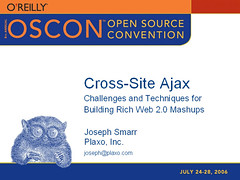Named Entity Recognition with Character-Level Models
HLT-NAACL CoNLL-03 Shared Task
Edmonton, Canada
June 1, 2003
Download PDF (4 pages)
Download PPT (3.8MB; presentation at CoNLL-03)
Every year that Conference on Computational Natural Language Learning (CoNLL) has a “shared task” where they define a specific problem to solve, provide a standard data set to train your models on, and then host a competition for researchers to see who can get the best score. In 2003 the shared task was named-entity recognition (labeling person, place, and organization names in free text) with the twist that they were going to run the final models on a foreign language that wouldn’t be disclosed until the day of the competition. This meant that your model had to be flexible enough to learn from training data in a language it had never seen before (and thus you couldn’t hard-code English rules like “CEO of X” –> “X is an organization”).
Even though my first paper on character-level models got rejected, we kept working on it in the Stanford NLP group because we knew we were on to something. Since one of the major strengths of the model was its ability to distinguish different types of proper names based on their composition (i.e. it recognized that people’s names and company names usually look different), this seemed like an ideal task in which it could shine (see my master’s thesis for more on this work). By this time, I’d started working with Dan Klein, and he was able to take my model to the next level by combining it with a discriminatively trained maximum-entropy sequence model that allowed us to try lots of different character-level features without worrying about violating independence assumptions (a common problem with generative models like my original version). Dan’s also just brilliant and relentless when it comes to analyzing the errors a model is making and then iteratively refining it to perform better and better. The final piece of the puzzle came from my HMM work with Huy Nguyen, which let us combine segmentation (finding the boundaries of proper names in text) and classification (figuring out which type of proper name it is) into a single model.
Our paper was accepted (yay!) and Dan and I flew to Canada to present our work. This was my first NLP conference and it was awesome to meet all these famous researchers whom I’d previously read and learned from. Luckily for me, Dan was just about to finish his PhD, and he was actively being courted by the top NLP programs, so by sticking with him I quickly met most of the important people in the field. Statistical NLP attracts a fascinating mix of people with strong math backgrounds, interest in language, and a passion for empirical (data-driven) research, so this was an amazing group of people to interact with.
On the last day of the conference (CoNLL was held inside HLT-NAACL, which were two larger NLP conferences that had also merged), the big day had come at last. My first presentation as an NLP researcher (Dan let me give the talk on behalf of our team), and the announcement of the competition results. There were 16 entries in the competition. In English (the language we had been given ahead of time), our model got the 3rd highest score; in German (the secret language), our model came in 2nd, though the difference between our model and the one in 1st place was not statistically significant. In other words, had the test data been slightly different, we might easily have had the highest score.
Doing so well was certainly gratifying, but what made us even happier was the fact that our model was far simpler and purer than most in the competition. For instance, the model that got first place in both languages was itself a combination of four separate classifiers, and in addition to the training data provided by the conference, it also used a large external list of known person, place, and organizaton names (called a gazetteer). While piling so much on certainly helped eek out a slightly higher score, it also makes it harder to learn any general results about what pieces contributed and how that might be applied in the future.
In contrast, our model was almost exclusively a demonstration of the valuable information contained in character-level features. Despite leaving out many of the bells-and-whistles used by other systems, our model performed well because we gave it good features and let it combine them well. As a wise man once said, “let the data do the talking”. Perhaps because of the simplicity of our model and its novel use of character features, our paper has been widely cited, and is certainly the most recognized piece of research I did while at Stanford. It makes me smile because the core of the work never got accepted for publication, but it managed to live on and make an impact regardless.
 After four years as an undergraduate at Stanford, I wasn’t ready to leave yet. There were more classes I wanted to take, and I wanted to do more research. Since I was in the
After four years as an undergraduate at Stanford, I wasn’t ready to leave yet. There were more classes I wanted to take, and I wanted to do more research. Since I was in the 
 Plaxo sponsored me to give a talk at the beginning of MashupCamp2 (alongside
Plaxo sponsored me to give a talk at the beginning of MashupCamp2 (alongside 